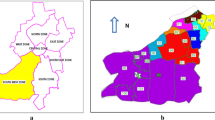Abstract
As bus users give up riding buses and choose the other alternatives when walking times to bus stops are longer than their marginal walking time, whether the bus stops are available within the marginal walking time at origin and destination of their travel affects definitely to bus users’ bus service selection. Therefore, bus service coverage area should be decided considering reasonable walking distance or time from bus stops. In this study, an ANFIS model to estimate the marginal walking time was constructed by employing the variables of age, income and present walking time which have fuzzy characteristics among individual attributes of bus users. Predictability of the model was evaluated by comparing the surveyed and the estimated values. Based on the statistics of coefficient of determination, MSE and MAE, it may be judged that the explainability of the model is very high, the values of the statistics being 0.996, 0.163, 0.333 respectively. The marginal walking time estimated by inputting the average values of age and income of Jinju City bus users to the model was close to the mean of the surveyed. The technique developed in this study can be applied to other cities. Analyzing the relationship between marginal walking time and age/income by using the model, the marginal walking time decreases slowly after the age of 28 years and is inversely proportional to the income.
Similar content being viewed by others
References
Fuzzy Logic Toolbox for Use With Matlab User’s Guide Version 2.0 (2000) The MathWorks, Inc.
Hines, J.W. (1997) Matlab Supplement to Fuzzy and Neural Appro-Aches iN Engineering, John Wiley & Sons, Inc.
Kim, J.S. and Won, Y.S. (2005) “Determination of a bus service coverage area reflecting passenger attributes.” Journal of Korea Society of Transportation, Vol. 23, No. 3, pp. 149–159.
Nelson/Nygaard Consulting Associates (1997) Tri-met transit network phase II report, Portland, PA.
Oh, Juwon, Roschke, P.N., Lin, P.-Y., Carlson, J.D., and Sunakoda, K. (2004). “Experimental beavior and neuro-fuzzy modeling of 30-ton magnetorheological damper.” KSCE Journal of Civil Engineering, Vol. 8, No. 2, pp. 213–219.
Spasovic, L.N. and Schonfeld, P.M. (1993). “Method for optimizing transit service coverage.” Transportation Research Record 1402.
Spasovic, L.N, Boile, M.P., and Bladikas, A.K. (1994). “Bus transit service coverage for maximum profit and social welfare.” Transportation Research Record 1451.
Transportation Research Board (1999). A Handbook for Measuring Customer Satisfaction and Service Quality, National Academy Press, Washington, DC.
Transportation Research Board (2003). Transit Capacity and Quality of Service-2nd Edition: 3-9-3-11, TCRP Report 100, Washington, DC.
Author information
Authors and Affiliations
Corresponding author
Rights and permissions
About this article
Cite this article
Kim, K.W., Lee, D.W. A model to estimate the marginal walking time of bus users by using adaptive neuro-fuzzy inference system. KSCE J Civ Eng 12, 197–204 (2008). https://doi.org/10.1007/s12205-008-0197-7
Received:
Accepted:
Published:
Issue Date:
DOI: https://doi.org/10.1007/s12205-008-0197-7




